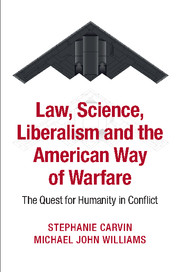Book contents
- Frontmatter
- Contents
- Prologue
- Introduction
- 1 Law and science in the Western way of war
- 2 The American way of war
- 3 Vietnam and the “science” of war
- 4 Immaculate destruction: reorganization, revolution and re-enchantment of War
- 5 Revolution denied: the “war” on terror
- 6 Back to the future?
- Index
- References
2 - The American way of war
Published online by Cambridge University Press: 05 December 2014
- Frontmatter
- Contents
- Prologue
- Introduction
- 1 Law and science in the Western way of war
- 2 The American way of war
- 3 Vietnam and the “science” of war
- 4 Immaculate destruction: reorganization, revolution and re-enchantment of War
- 5 Revolution denied: the “war” on terror
- 6 Back to the future?
- Index
- References
Summary
What is war? War embraces much more than politics … it is always an expression of culture, often a determinate of cultural forces, in some societies the culture itself.
John Keegan, A History of WarfareThe Americans, as a race, are the foremost mechanics in the world. America, as a nation, has the greatest ability for mass production of machines. It therefore behooves us to devise methods of war which exploit our inherent superiority.
General George S. Patton, War As I Knew ItAlthough the early American officer corps drew on the common canon of writings of great European military leaders when the country fought for independence against the British Crown, and the US military continued to engage with the development of military science in Europe post-independence from Great Britain, the American experience in war in the New World of the North American continent differed from that of the Old World. The American historical experience beyond continental Manifest Destiny reinforced a uniquely American approach to Western warfare. To understand how Americans fight war, it is necessary to understand how Americans view war. This is because how a country conceptualizes and understands war directly impacts how that country instrumentalizes war as a tool of policy.
The particular American preference for decisive, overwhelming conflict becomes apparent when one takes into consideration three factors. First, historically the Western way of war is driven to decisive victory by economic constraints that go back in history to the Greek city-states discussed in the previous chapter. Second, the United States, as a contemporary liberal power, considers war an aberration – thus it views conflict as the suspension of civilized politics to engage in a dirty task that should be accomplished as quickly as possible. Finally, and again historically in line with the Western way of warfare, the democratic nature of the contemporary United States necessitates that wars are fought in a timely matter. Just like in ancient Greece, the public will only fight for a certain amount of time before domestic affairs and political infighting consume attention that was hitherto directed, in a somewhat unified manner, on a common war effort.
- Type
- Chapter
- Information
- Law, Science, Liberalism and the American Way of WarfareThe Quest for Humanity in Conflict, pp. 55 - 87Publisher: Cambridge University PressPrint publication year: 2014



